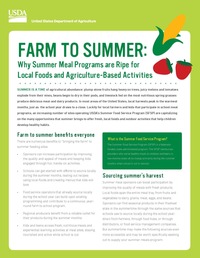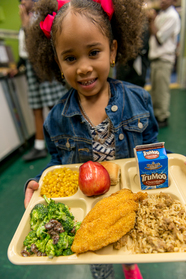|
May 26, 2015 | Volume 4, Issue 13
Feature
Spotlight on Summer: How do you "bring the farm" to your summer meals program?
 USDA Photo
Last
year we asked you to share your story about incorporating fresh local foods
and fun farm-based activities in your summer meals programs. And you answered!
We highlighted an abundance of local fruit and a "meet the farmer" event in Dallas,
TX, innovative local procurement practices in Kalispell, MT, local
sourcing and scratch cooking on wheels in the Northeast Kingdom, VT, and
school gardens in full bloom in Marion, OH.
Your
stories showed that there are many benefits to starting or continuing farm to
school activities in the Summer
Food Service Program (SFSP). Local foods and agriculture-based activities
at summer sites can improve the quality and appeal of summer meals, address the
learning and nutrition gap that can occur when school is out, bolster your farm
to school efforts with continuous, year-round programming, and support local
and regional food systems all year long. We’d love to continue the conversation
about how you make this all possible. So
send us a photo or two and a description of how you bring local, nutritious
foods to kids and teens during the summer months, and we’ll feature the most
creative practices in our E-letter and/or on our blog to shine a spotlight on
your programming!

 Summer resources
Check
out the new Farm to
Summer page on our website for USDA and partnering organization resources.
Our Farm to Summer Fact Sheet provides tips for incorporating local foods and agriculture-based activities into summer meal programs.
USDA’s Summer Food Service Program (SFSP) Toolkit
features material on incorporating local foods and related activities into
summer meals programs. Whether you’re a state or local agency, nonprofit partner, school district, or producer/provider,
you’ll find helpful hints here on ways to continue farm to school activity
while school is out.
|
Webinars
Make the "best of fresh" with farm to school
Wednesday,
May 27, 3:00 EDT: Christina Conell from USDA’s Farm to School Program joins Carol
Chong, National Nutrition Advisor, Alliance for a Healthier Generation Healthy
Schools Program to bring you information about making local purchases. Local products can come from local farmers, ranchers, fishers,
food processors and distributors of all sizes. This webinar will help you
define “local,” provide tips on how find local
foods, learn procurement principals and regulations, and learn how to span the
school meal tray.

Tying
it all together and digging in
Thursday,
May 28, 2:00 EDT: Join
us for a healthy dose of motivation! Deborah Kane, National Director of USDA’s
Farm to School Program, will hit the highlights by showing how local
procurement fits into the larger farm to school picture and share resources
available to help you develop a comprehensive farm to school program.
Missed
a webinar in our series? All webinars are recorded and available on our website!


Bits from Blogs
Photo-worthy meals
Posted by Deborah Kane, National Director, USDA Farm to
School Program
They say a picture is worth a
thousand words, and in the digital age we have ample opportunity to document
and broadcast every moment, meeting and meal. We have all seen those
unappetizing photos of food served at school that quickly go viral. A lonesome
whole wheat bun atop a sad fish fillet; a mysterious-looking meat mixture
served next to an apple. It’s natural to ask, “Is this what they serve for
lunch!?”
No, it’s really not.
In my ideal world, the Internet
would be abuzz with photos like the one above, also a school lunch featuring a fish fillet, taken at Samuel J. Green Charter
School in New Orleans. One of the first public schools to open in New
Orleans post-Katrina, the mission of Samuel J. Green Charter School is to
prepare 100 percent of its students for college, careers and a successful life.
Central to leading a successful
life is living a healthy
life, and Green fosters an atmosphere where healthy eating and nutrition
education are central to the core curriculum.
With funding from the USDA Farm
to School Grant Program, FirstLine
Schools, which operates its signature program, the Edible Schoolyard New Orleans, Green and
four other schools in New Orleans set out to make sure that at least five
percent of all the foods offered in its cafeterias were sourced locally. With
help from Chartwells, a food service management company, FirstLine has exceeded
this goal; today, 11 percent of the food that is served comes from nearby farms
and food businesses. In the meal pictured above, the rice medley, apple and
milk are all from local partners, while the broccoli salad was made on site.
|

|